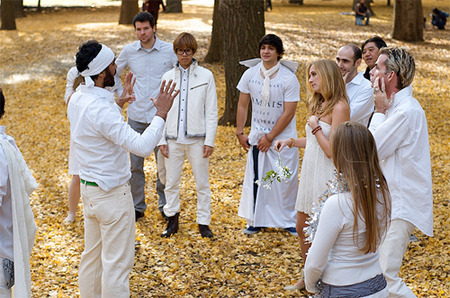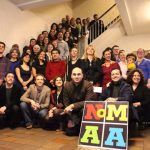The Business of Art: An Interview with Trust Art
Public art is for the people. Whether object-based, performative, or interactive, public artworks are created to enhance the landscape of a public space by giving communities something out of the ordinary to reflect on, consider, and engage with. Trust Art, founded by Seth Aylmer and Jose Serrano-McClain, is an organization and philanthropic initiative that is not only invested in public art, the artists that create it, and the communities that share it, but also in finding ways to sustain the lifeline of public art projects. Trust Art has developed a three-year cycle that involves “shareholders,” community members that invest money, time, and other resources into public projects in exchange for “shares,” which are redeemed upon the project’s auction at the end of the three-year cycle. Currently Trust Art is producing and supporting the growth of 10 public art projects in New York City and around the world, all of which are invested in by “shareholders,” community members, and a network of artists. I recently sat down with Seth and Jose of Trust Art to discuss the history of the organization and their current pursuits.
TC: Let’s talk about what Trust Art is and how it got started.
SA: Trust Art is a community organization that supports public art projects, mainly through online donations, and also by bringing larger groups of people together to help accomplish certain projects. There’s a very specific model attached to Trust Art that makes it separate from traditional fundraising in that we are throwing this auction at the beginning of 2012. It’s something that we want to do every three years if the model works out. Basically everyone who’s donated to a particular project owns a stake in a work that will end up at that auction and be sold. So, if the work sells at auction for more than it costs to make, the money will be given back to the people who invested in it.
JS: What I think we’re doing is experimenting with ways to lay the infrastructure for people working on social practice and public art projects—that infrastructure being not only about how the project is funded, but how the project is grown. For us that’s actually more important than the simple idea of whether a project is funded or not, which is not the primordial question that drives what we do, or what the projects are about, and that’s one of the ways we differentiate ourselves from the Kickstarter model. We enable artists with ambitious visions to not only raise capital, but also draw on a community of people willing to contribute their time and ideas, and make something that is bigger than any one person can achieve. So, it’s not a question of, can we fund this or not? Where we are hoping to add a little bit of richness to this process is in the way that we observe how projects are growing as they grow. For example, we just had a block party a few weeks ago that we did in collaboration with Factory Fresh, the mobile app company All City, and an artist who proposed that this small street in Bushwick be converted into a sculpture park that would be curated by artists. The block party was the first chapter of this project. We raised the money that we could to have that happen—it took a lot more than money; it took a lot of partnerships. Now we are going back to the drawing board and figuring out where can we grow from here, and over time we’ll have a series of actions and the momentum to achieve something much more complex, which is the demapping of a street, an alliance with a number of community partners, and essentially a story left behind of something that was really cool for the way it happened.
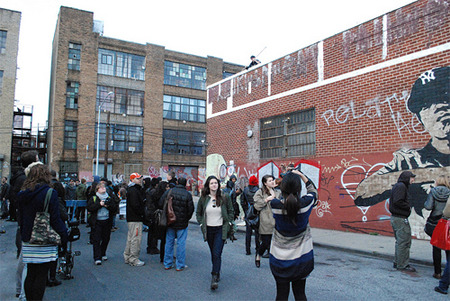
TC: How do you quantify or qualify a project’s growth?
SA: Let’s take as an example the Dreamers Project, which is a series of group portraits from around the world. In that case there was a first portrait in Brooklyn, and that really catalyzed the momentum that the artist had in mind, and the image from that was then used to promote the next shoot in Mexico City. We needed an awesome location for the next shoot, which ended up being at the Diego Rivera Museum. A journalist heard about the project and ended up recruiting a good amount of people to come out to the shoot. All of that created a network that added to the online component of the project. We got everyone’s email addresses, and they were all updated for the next photo shoot. For each photo there was an event that brought a number of people together around this art project, and that’s something that didn’t just fall away; it grew with every shoot.
TC: This idea of sustainability with a project is not as a continuous line but the slow steady growth of an idea.
SA: It’s hard to mesh that with capitalism, which is all about moving money. That’s why we’ve taken this incremental approach where you just do what you can and trust that that will create momentum for the next chapter.
TC: Two questions: Would you describe your roles as predominantly creative administrators, attempting to build these projects through networking and funding and working directly with artists, or is it something else? And my other question is, did this idea grow out of something you took issue with or that you felt you could improve?
SA: To answer your first question, I would say that yes, “creative administrator” is a fairly accurate description of what we’re doing.
JS: The idea of Trust Art goes back to our first driving question and problem, which is that there are people who have fame and social capital, and people who need it. Five years ago, when we first formed our partnership, Paris Hilton was the most notorious media story/non-media story. It seemed like we had reached a new level of absurdity with the distance between the people who had attention and the people who didn’t have attention who could use attention—people like us, people like our friends who have something to give. In a way, we started this as a documentary to create a fictional celebrity out of thin air.
SA: It’s called Fame Game now; it’s an online business and media site. It ranks people rising and falling in the media, and it has advertising, which brings in revenue. We don’t work at the company anymore, but Trust Art came out of that.
JS: I was really geeking over data, and thought, well, could we make a rigorous study of celebrity, could we create a very rigorous data set around fame? We partnered with people at Eyebeam to write the first algorithm. It started getting a lot of traffic for simply ranking people’s media attention and social connections, and we saw the opportunity to create a kind of community through it in which we would turn that currency of social capital into something that they could invest into new artists and new philanthropic projects to balance that imbalance that we saw by using this source of energy in New York that we call social influence and media attention. So we worked for a few years toward that vision by forming various partnerships. And, in a way, it has succeeded in its own right, but we never got the chance to create the community of people investing their capital.
We decided we needed to focus on that rather than on media capital. If you create the right story, the media will come, but art takes time, money, and resources. We had started to triangulate how to channel media capital and social capital, and we realized that maybe the Internet wasn’t the best place to conduct that kind of project. But it is a good place to potentially raise awareness, participation, and actual dollars. We were partially inspired by Kiva, the first online community to successfully channel capital to people and projects that needed it in a way that blurs the line between philanthropy and capitalism. Having had a past career at the Federal Reserve, having met Seth, and having a new appreciation for the idea of playful storytelling and mythmaking, this idea of financial shares—and then, eventually, shares that you get through investing time and material goods—emerged as a kind of organizing principle around this gift economy. But it is meant to be, and is, primarily a way to catalyze a gift economy that goes from the community to the artist, and from the artist back to the community. And if that circle can be completed, then that makes for a better system, a better mechanism.
TC: I’m actually the one person who takes issue with the gift economy, or I should say I like it but I think it’s problematic in the way that we talk about it. I so often feel like “gift economy” is this buzz phrase that everybody just overuses and we don’t really have meaningful conversations about it, because no one really knows what it is. I feel like resource allocation has become what people think the gift economy is. If I give you money, or scrap wood that I paid for but don’t need any more, that could be considered resource allocation, but that’s not necessarily gift economy. Gift economy is when I expect something back from you, like time, even if it’s unspoken. That’s my idea of what gift economy is.
JS: I’ll just correct one thing: it’s when you can expect it from the rest of the community, not directly from that one person.
TC: Well, this is why I appreciate talking about it because the term is often applied to one-on-one interactions, and I don’t think it should be. What happens when I invite you over for dinner and we have steaks and lobster and the finest Bordeaux from a hundred years ago, and then when you invite me over for dinner we have Ramen? Value is never talked about with the gift economy—we’re just supposed to value the bigger picture.
SA: Your concerns about the gift economy probably echo a lot of peoples’, but I think that there actually is value attributed to it in certain cases. I don’t know if you read the book The Gift, but in it Lewis Hyde writes about traditional gift economies among indigenous peoples in the U.S. who would throw these potlatchs and it was literally about who could throw the biggest one—who could be the most giving.
TC: But why? Because of karmic benefits?
SA: Because if I go to your house and you make me steak and lobster, I’m going to think you’re awesome.
TC: Maybe, maybe not.
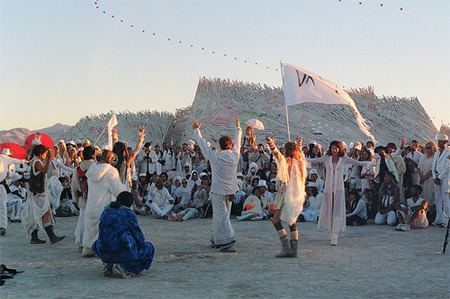
SA: I think you’d be popular. And I do think it exists in a more evolved form than what you’re talking about. We went to Burning Man for the first time this year, and there is actually a functioning gift economy there. Once you get there, there’s no money. You give whatever you’ve brought, and you’re going to get whatever everyone around you has brought and is giving away. There’s an abundance of materials and you never know what you’re going to get. Jose needed a coat and some guy gave him a coat.
TC: So, it’s a lot about sharing. But the guy didn’t give you the coat off his back, right?
JS: No, he literally brings coats every year because he knows that every year there will be people who are there for the first time who didn’t realize that it gets a little colder at night than you would think. For me what is super interesting is that there’s an identification with living in a society whose main value is to give, and that at Burning Man, just like in some small-scale societies, status belongs to the people who give the biggest gifts. In a strange way, this kind of free market principle emerges out of this gift economy; people compete in the most spectacular ways to be the best camp that offers lemonade. To me, for someone who’s a geek of both the free market and the gift economy, which are supposed to be two separate things, I’m literally seeing free market behavior in a gift economy.
TC: If our human desire is actually to give and that might be true for many reasons, social or otherwise, maybe it’s also combined with our desire to have and to be the best.
SA: In terms of status.
TC: And in terms of achievement.
JS: Yes, there is a real sense of gain.
TC: How are your ideas about the gift economy and capitalism contextualized within Trust Art?
SA: In many ways, Trust Art was trying to marry those two things. We were both influenced by The Gift, the last chapter of which is literally about reconciling the contradictions between the gift economy and capitalism. For instance, scarcity plays a much larger role in capitalism, whereas abundance is the goal, or the context, of the gift economy. In thinking about it in relation to the art world, we realized there were all these public art projects that we wanted to do, and there were all these artists in our community that have the drive to do this kind of work. Could we get the larger community to participate in these public art projects by donating time, money, or materials, and have it not just be a pure donation? We never wanted Trust Art to be an organization that was raising money from rich people and giving it to artists. We wanted to complete the circle a little more, and see if that could actually make it an economy. So that’s when we thought of auctioning the works that are made by the artist with support from the community, and if the works sell for more than what they cost, there’ll be money left over for the next round.
JS: Part of our goal in having shareholders in these projects is to involve them in decisions as much as possible. The donor relationship ends after a donation; a shareholder, though, gets invited to a conference, and has a voice in the goings-on of the enterprise.
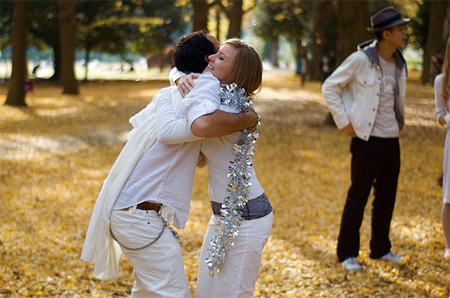
TC: And how do those voices place in the hierarchy of voices within Trust Art, with you and with the artists? How are those voices weighed against the other voices involved?
SA: When we were trying to figure out a location for the Dream shoot in Tokyo, we had emails of roughly 20 people in Tokyo—all friends of friends—and we had the two of us. We also had Justin, the photographer, and we had a few other people who are supporters of the project—financial supporters and people who were just friends who wanted to be a part of it and give their time. And there was this crazy, awkward, rolling conversation where people were just throwing out ideas and other people were batting them down. There was no particular method to how that conversation happened—
JS: It was kind of a town hall meeting. The most important thing was that everybody had a voice, and that everybody else has access to that voice. And if momentum emerges from anywhere, we would not get in the way of it.
Our job is to make it transparent, and ensure that everybody has access to and can influence projects’ growth. We’ve been talking about how to document people’s donations of time, and how to assign monetary value to these donations.
TC: Who are the artists you’re funding and supporting?
SA: The group we have now are all people we already knew. So we never did an open call; we reached out to all the people who we were connected with and were part of our lives and who we trusted, and that’s what composed this first group of 10 people. One thing these artists have in common is that they all have a public component to their work, something that directly interacts with people outside the gallery context. The Dreamers Project is a group of portraits that are taking place in seven cities around the world, and they are all united to send this very simple message of “dream.” And the artist, Justin, has chosen for everybody to wear white and there’s a flag bearer typically in every image that is waving a flag that says “dream” in the native language of the country that we happen to be in.
JS: Another project is the Humanity Project, this project where we worked with a perfumer who’s an artist as well, and she is now my wife.
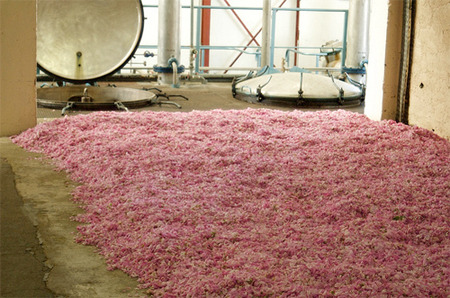
The Humanity Project is cool because we’ve been working with scent. In our case, the question that drove that project was, Can you create a perfume that can inspire a sense of compassion and empathy, and how could we deliver the scent in the public realm? This project is based on the belief that scent is a very powerful emotive medium since it has the power to trigger memories. If you can figure out a scent that can trigger certain memories—especially ones that make you feel a sense of empathy—then you could potentially create a scent that inspires empathy. So the project began with an inspiration trip. The idea was that if Anne could form a very vivid memory of an act of compassion, she would formulate a scent based on the experience. So she brought a bunch of us to volunteer at an orphanage in Mexico for a week.
My life changed in those six days… At the end of it I truly believed that we could manufacture compassion through scent.
TC: So what did that manifest into?
JS: Anne finished her time at the Grasse Institute of Perfumery, where she was studying. She composed a perfume at Grasse, and when she came back to New York the first thing we talked about was how to put a fountain in a public park. Our first idea was actually a huge scented wax fountain. Somehow we got the permit for installing a scented fountain made out of glass that would be safe for the environment. But it was vandalized in the first few weeks.
TC: Do you think people in the neighborhood felt threatened, or that their space was infiltrated?
JS: What are you going to do, never put anything fragile in a public place? Every now and then you have to break from that idea, because otherwise it will become a self-fulfilling prophecy and nothing will ever be made with any trust for each other. The fountain got broken and it turned out to actually be wonderful, because how else would we have been featured in the New York Times?
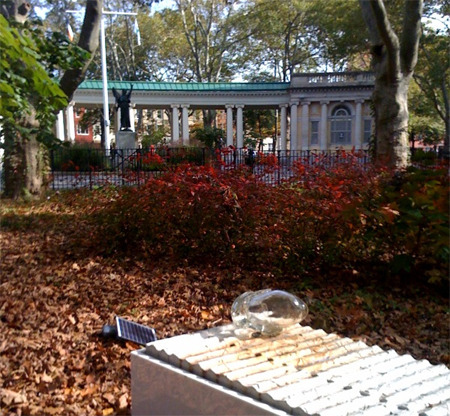
TC: How does someone go about making a donation (to Trust Art)?
SA: On the Trust Art website. So whatever particular chapter a project is in, there’s a page where you read about the current chapter and next to that there’s a place where, if you’re so inclined, you can make a gift and become a shareholder.
TC: And the chapters are the different stages of sustainable growth?
JS: Right. The way we like to think about them, or maybe obsess about them, is, first of all, whether this is a good story. This is not just about phases, it’s about how these projects and how this network of projects tells a story about our ability to create art for the public. It allows us to track really interesting things: Who has always invested in a chapter one of a project? In a way, who’s an earlier-on investor? Who’s more risk hungry? Who’s more adventurous? But also, who continues to invest? How many chapters have you invested in throughout this project? We are culling these pieces of data into stories in the profiles that each shareholder has online.
TC: So each shareholder has a profile online which consists of…?
SA: Which consists of a record of their shares. So if they’ve donated time or money to a project it’s recorded there.
TC: What’s the average donation that people give you? Do you subscribe to the idea that no donation is too small? If I donate ten dollars and another person donates a hundred dollars, are we equal shareholders? Tell me more about how it all works.
SA: A share is a dollar, so it’s one-to-one. The more shares you have in a project, the more money you’ll get from its sale at auction, assuming it sells at a profit.
JS: As far as the average donation, I have to say, we have a very high average. It’s between 25 and 50 dollars.
TC: How many shareholders do you have now?
JS: Probably 300.
TC: That’s really wonderful. Is that the most you’ve had, or has it been higher?
JS: Once you’re a shareholder, you’re holding shares until the auction. It’s cumulative.
TC: And the auction will be in February 2012?
SA: Yes, three years from when we launched Trust Art. And we’re hoping to do that again, every three years.
TC: With all new projects?
JS: The way this is probably going to play out is we’ll schedule an auction every three years, and whatever projects can participate in that auction at the time, that’ll be great.
Seth Aylmer is a sculptor who works in the public realm. His last sculpture, The Helper, is now on view in Marcy Green South Park in Williamsburg, Brooklyn, where he also lives. Seth is also the co-founder of the Trust Art collective in Brooklyn, NY, an arts group that crowdsources funding to create public art.
Jose Serrano-McClain worked as an economic analyst at the Federal Reserve Bank of New York for five years, where he realized he would rather be thinking about the economics of the creative spirit. In 2006, Jose resigned from the Fed to become an “art entrepreneur.” He cofounded Fame Theory, LLC, an art collective turned media company that operates famegame.com. In 2009, he cofounded Trust Art, an initiative dedicated to working with public artists to raise funds and create community around their visions through innovative means. In 2010, Jose joined the Queens Museum of Artpart-time to create a new public art program called Corona Studio.
Tracy Candido is a Brooklyn-based artist and cultural producer exploring social practices and engaging the public in group activities. She has exhibited public works in and around New York City and has curated interdisciplinary exhibitions and public programming for institutions in New York around the country. She is a founding editor of127 Prince, an online journal about socially engaged art. Tracy holds a Master’s Degree from New York University in Visual Culture Theory and is currently a Program Associate in Programs and Awards at NYFA.

